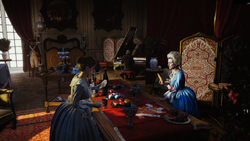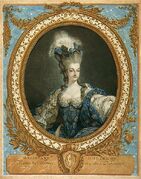标签:可视化编辑 |
小 (小编辑,未翻译) |
||
| (未显示3个用户的25个中间版本) | |||
| 第1行: | 第1行: | ||
| + | {{Era|Individuals}} |
||
| − | '''玛丽·安托瓦内特'''(''Marie Antoinette'',1755年11月2日 - 1793年10月16日)是[[法国]]王后,[[路易十六]]的妻子,大革命期间被送上断头台。 |
||
| + | {{WP-REAL|zh:玛丽·安托瓦内特}} |
||
| + | {{翻译请求}} |
||
| + | {{Quote|Bring us more of this cake!|Marie Antoinette to a servant.|刺客信条:团结}} |
||
| + | {{Character Infobox |
||
| + | | image = ACU Marie Antoinette Render.png |
||
| + | | birth = 2 November 1755<br>[[Vienna]], [[Holy Roman Empire]] |
||
| + | | death = 16 October 1793 (aged 37)<br>[[Paris]], [[First French Republic|French Republic]] |
||
| + | | species = [[Human]] |
||
| + | | affiliates = [[House of Bourbon]]<br>[[Kingdom of France]] |
||
| + | | voice = [[Melissa Robertson]] |
||
| + | | database = [[Database: Marie Antoinette|Marie Antoinette]]}} |
||
| + | '''玛丽·安托瓦内特'''(''Marie Antoinette'',1755年11月2日 - 1793年10月16日),洗礼名:'''玛丽亚·安托妮亚·约瑟芬·约翰娜'''(''Maria Antonia Josepha Johanna''),was the wife of [[Louis XVI of France|King Louis XVI]] and Queen of [[France]] and [[Navarre]] from 1774 to 1792. Hated by the [[France|French]] people and imprisoned during the [[French Revolution]], she was [[guillotine]]d in 1793. |
||
| + | |||
| + | ==生平== |
||
| + | ===Early life and reign=== |
||
| + | Marie Antoinette was born in 1755 to [[Holy Roman Empire|Holy Roman Empress]] {{Wiki|Maria Theresa}}.<ref name="Marie Database">《[[刺客信条:团结]]》— [[Database: Marie Antoinette|数据库:玛丽·安托瓦内特]]</ref> In 1770, she married Dauphin Louis-Auguste, the future King Louis XVI. During a fireworks display on their wedding day, official figures state that 132 people were trampled to death in a stampede. In 1774, [[Louis XV of France|Louis XV]] died, leaving Louis XVI and Marie Antoinette as King and Queen of France. Seven years into their marriage, Marie Antoinette and Louis provided France with an heir, having long been ridiculed by the French people for failing to do so.<ref name="Louis Database">《刺客信条:团结》— [[Database: King Louis XVI|数据库:路易十六国王]]</ref> |
||
| + | |||
| + | After becoming Queen, Marie Antoinette took on [[Rose Bertin]], who she had met in 1772, as a fashion advisor. Bertin became known as the Queen's "minister of fashion", assisting her in transforming the dress code of [[Versailles]]. Dresses were simplified, especially through eschewing the cumbersome panniers, allowing women greater freedom of movement. On special occasions, she would play the tune to [[Ça Ira]], which she was especially fond of, on the harpsichord.<ref>《刺客信条:团结》— [[Database: Rose Bertin|数据库:罗斯·贝尔汀]]</ref> |
||
| + | |||
| + | Shortly into her reign, Marie Antoinette had by many accounts become the most hated woman in France. Described as "petty, frivolous, mocking", she hosted large parties and spent money lavishly. Her mother claimed that "she [was] rushing toward her ruin". The population regarded Marie Antoinette with suspicion, and gossip accused her of being too influential in Louis' decisions. With France's economy in tatters after the [[American Revolutionary War]] and the excessive spending of nobles such as Marie Antoinette herself, the French people grew increasingly discontent with the monarchy.<ref name="Marie Database" /> |
||
| + | |||
| + | ===Outbreak of the revolution=== |
||
| + | [[File:Women's March 4.png|thumb|250px|Marie Antoinette at the Palace of Versailles]] |
||
| + | In the spring of 1789, Marie Antoinette encouraged Louis towards a wavering and contradictory policy. She opposed reform of France's economy and played a vital part in the dismissal of finance minister [[Jacques Necker]]. As the French Revolution broke out, Marie Antoinette believed that foreign intervention would preserve the monarchy. Around this time, her son, the {{Wiki|Louis Joseph, Dauphin of France|Dauphin Louis Joseph}}, died of tuberculosis. Following [[Théroigne de Méricourt]]'s [[Women's March on Versailles|march on Versailles]], Louis and his family were forced to move to the [[Tuileries Palace]] in [[Paris]]. There, Marie Antoinette asked a magician to protect her from a [[Johannes Metzger|ghost]] that supposedly lived there.<ref name="ACU">《刺客信条:团结》</ref> |
||
| + | |||
| + | Refusing to accept support from the [[Gilbert du Motier, Marquis de Lafayette|Marquis de Lafayette]] and the [[Honoré Gabriel Riqueti, comte de Mirabeau|Comte de Mirabeau]], Marie Antoinette continued pressing on with a plan for escape. In 1791, she, Louis and their family attempted to escape Paris in the [[flight to Varennes]], intending to initiate a counter-revolution. They were soon arrested however, and returned to the Tuileries. Fearing intervention from neighbouring monarchies, revolutionaries stormed the Tuileries on [[10 August]] the following year. As the royal family took refuge with the [[Legislative Assembly]], the French monarchy was dissolved and they were imprisoned in the [[Temple (Paris)|Temple]].<ref name="ACU" /> |
||
| + | |||
| + | ===Imprisonment and death=== |
||
| + | While Louis was executed for treason on 21 January 1793, Marie Antoinette was moved to the [[Conciergerie]] on 1 August that year. During her imprisonment, she plotted with Mirabeau's friends to escape as part of the Carnation Plot. Receiving a secret message hidden inside the petals of a carnation, she pin-pricked her response into a piece of paper.<ref name="ACU" /> |
||
| + | |||
| + | The gendarme [[Jean Gilbert]] was then supposed to bring the message to Marie Antoinette's allies outside the prison, in return for 400 louis, a sum equivalent to three years' pay. Much to the annoyance of public prosecutor [[Antoine Fouquier-Tinville]], several of her captors felt compassion for her, some even bringing her flowers.<ref name="ACU" /> |
||
| + | |||
| + | However, Gilbert was secretly a [[Templars|Templar]] agent, and revealed the plot, ending any hopes of survival for the Queen.<ref name="ACU" /> She was tried by the Revolutionary Tribunal on 14 October. On 16 October, she was sentenced to death for high treason, being [[guillotine]]d later that day.<ref name="Marie Database" /> Following Marie Antoinette's death, [[Marie Tussaud]] created a wax sculpture of her head.<ref>《刺客信条:团结》— [[Database: Madame Tussaud|数据库:杜莎夫人]]</ref> |
||
| + | |||
| + | ==画廊== |
||
| + | <gallery captionalign="center" position="center" spacing="small" widths="180"> |
||
| + | Marie-Antoinette;_koningin_der_Fransen.jpg|玛丽·安托瓦内特油画 |
||
| + | Marie_Antoinette_Young2.jpg|12岁的玛丽·安托瓦内特 |
||
| + | Marie Antoinette - Head Renders.jpg|Head renders of Marie Antoinette |
||
| + | MarieAntoinettePortrait.jpg|A portrait of Marie Antoinette |
||
| + | Women's March 5.png|Marie Antoinette accepting a drink |
||
| + | </gallery> |
||
| + | |||
| + | ==登场作品== |
||
| + | *《[[刺客信条:团结]]》{{1st}} |
||
| + | *《[[刺客信条:团结(小说)|刺客信条:团结]]》小说 |
||
| + | |||
| + | ==参考与来源== |
||
| + | {{Reflist}} |
||
| + | {{ACU}} |
||
| + | {{DEFAULTSORT:MaLiAnTuoWaNeiTe}} |
||
| + | [[en:Marie Antoinette]] |
||
| + | [[Category:所有页面]] |
||
| + | [[Category:人物]] |
||
| + | [[Category:历史人物]] |
||
| + | [[Category:刺客信条:团结人物]] |
||
| + | [[Category:刺客信条:团结(小说)人物]] |
||
| + | [[Category:1755年出生]] |
||
| + | [[Category:1793年死亡]] |
||
| + | [[Category:奥地利人]] |
||
| + | [[Category:德国人]] |
||
| + | [[Category:法国人]] |
||
| + | [[Category:巴黎人]] |
||
| + | [[Category:凡尔赛人]] |
||
| + | [[Category:波旁王室]] |
||
| + | [[Category:哈布斯堡家族]] |
||
| + | [[Category:王妃]] |
||
2020年6月1日 (一) 10:50的版本
| 兄弟会需要你的帮助! 本条目包含未翻译内容。您可以帮助刺客信条维基来 翻译这个条目。 |
- “Bring us more of this cake!”
- ―Marie Antoinette to a servant.[来源]
玛丽·安托瓦内特(Marie Antoinette,1755年11月2日 - 1793年10月16日),洗礼名:玛丽亚·安托妮亚·约瑟芬·约翰娜(Maria Antonia Josepha Johanna),was the wife of King Louis XVI and Queen of France and Navarre from 1774 to 1792. Hated by the French people and imprisoned during the French Revolution, she was guillotined in 1793.
生平
Early life and reign
Marie Antoinette was born in 1755 to Holy Roman Empress Maria Theresa.[1] In 1770, she married Dauphin Louis-Auguste, the future King Louis XVI. During a fireworks display on their wedding day, official figures state that 132 people were trampled to death in a stampede. In 1774, Louis XV died, leaving Louis XVI and Marie Antoinette as King and Queen of France. Seven years into their marriage, Marie Antoinette and Louis provided France with an heir, having long been ridiculed by the French people for failing to do so.[2]
After becoming Queen, Marie Antoinette took on Rose Bertin, who she had met in 1772, as a fashion advisor. Bertin became known as the Queen's "minister of fashion", assisting her in transforming the dress code of Versailles. Dresses were simplified, especially through eschewing the cumbersome panniers, allowing women greater freedom of movement. On special occasions, she would play the tune to Ça Ira, which she was especially fond of, on the harpsichord.[3]
Shortly into her reign, Marie Antoinette had by many accounts become the most hated woman in France. Described as "petty, frivolous, mocking", she hosted large parties and spent money lavishly. Her mother claimed that "she [was] rushing toward her ruin". The population regarded Marie Antoinette with suspicion, and gossip accused her of being too influential in Louis' decisions. With France's economy in tatters after the American Revolutionary War and the excessive spending of nobles such as Marie Antoinette herself, the French people grew increasingly discontent with the monarchy.[1]
Outbreak of the revolution

Marie Antoinette at the Palace of Versailles
In the spring of 1789, Marie Antoinette encouraged Louis towards a wavering and contradictory policy. She opposed reform of France's economy and played a vital part in the dismissal of finance minister Jacques Necker. As the French Revolution broke out, Marie Antoinette believed that foreign intervention would preserve the monarchy. Around this time, her son, the Dauphin Louis Joseph, died of tuberculosis. Following Théroigne de Méricourt's march on Versailles, Louis and his family were forced to move to the Tuileries Palace in Paris. There, Marie Antoinette asked a magician to protect her from a ghost that supposedly lived there.[4]
Refusing to accept support from the Marquis de Lafayette and the Comte de Mirabeau, Marie Antoinette continued pressing on with a plan for escape. In 1791, she, Louis and their family attempted to escape Paris in the flight to Varennes, intending to initiate a counter-revolution. They were soon arrested however, and returned to the Tuileries. Fearing intervention from neighbouring monarchies, revolutionaries stormed the Tuileries on 10 August the following year. As the royal family took refuge with the Legislative Assembly, the French monarchy was dissolved and they were imprisoned in the Temple.[4]
Imprisonment and death
While Louis was executed for treason on 21 January 1793, Marie Antoinette was moved to the Conciergerie on 1 August that year. During her imprisonment, she plotted with Mirabeau's friends to escape as part of the Carnation Plot. Receiving a secret message hidden inside the petals of a carnation, she pin-pricked her response into a piece of paper.[4]
The gendarme Jean Gilbert was then supposed to bring the message to Marie Antoinette's allies outside the prison, in return for 400 louis, a sum equivalent to three years' pay. Much to the annoyance of public prosecutor Antoine Fouquier-Tinville, several of her captors felt compassion for her, some even bringing her flowers.[4]
However, Gilbert was secretly a Templar agent, and revealed the plot, ending any hopes of survival for the Queen.[4] She was tried by the Revolutionary Tribunal on 14 October. On 16 October, she was sentenced to death for high treason, being guillotined later that day.[1] Following Marie Antoinette's death, Marie Tussaud created a wax sculpture of her head.[5]
画廊
登场作品
参考与来源
| |||||||||||||||||||||||||||||||





